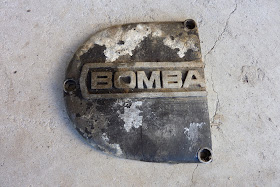When painting the Can-am engines I normally go for satin black. To take a quick break from the engine internals, I thought I'd clean up the oil pump cover and give it a quick coat to see what gloss looked like. Gloss is fine as long there are few imperfections in the surface but, because of the corrosion, I might not get away with it.
Hope there's metal under that corrosion.
Hope there's metal under that corrosion.
Oof! Needs a bit of a clean up! So a quick wire brush and I was left with this.
Time to get the rough wet and dry out. I used an 80 grit to get rid of the worst of the corrosion and start feathering the paint edges.
Corrosion evident on the outside too. Oh well, it'll add to the aged look!
Time for the 320 wet and dry. Looks like I'll end up with bare metal so 320 will be near to finish on. If flatting off a painted surface, you need to end up with 800 grit to avoid the scratches showing through the paint.
Time to degrease and lay on the paint. I did the underside and let it dry before turning it over and painting the side that matters. My favourite aerosol engine paint is PJ1 Fast Black . It goes on thick and the finish is superb. I'm using Septone engine enamel but it does take a little more effort to cover compared to PJ1.
. It goes on thick and the finish is superb. I'm using Septone engine enamel but it does take a little more effort to cover compared to PJ1.
Unsure as yet whether or not I like it. Might flat it off and use satin black instead.
Decisions decisions.































